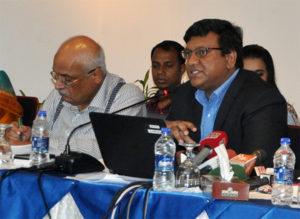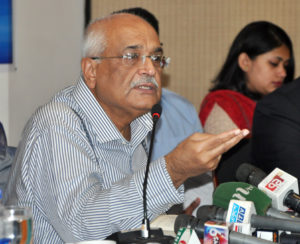
Bangladesh’s GDP growth rate is estimated to reach 7.2 percent in FY 2017. While achieving the growth figures have dominated attention, it has not been able to create more jobs in the economy. High growth was led by growth in the manufacturing sector which is increasingly becoming capital-intensive. Given that Bangladesh has a large and mostly unskilled labour pool, ensuring sustainable job creation is a priority for the country.
 These observations emerged at Centre for Policy Dialogue’s (CPD) media briefing where a report on the State of the Bangladesh Economy in FY2016-17 (Third Reading) and was released. The report has been prepared as part of CPD’s Independent Review of Bangladesh’s Development (IRBD) programme. The event was held at BRAC, Dhaka on 27 May 2017.
These observations emerged at Centre for Policy Dialogue’s (CPD) media briefing where a report on the State of the Bangladesh Economy in FY2016-17 (Third Reading) and was released. The report has been prepared as part of CPD’s Independent Review of Bangladesh’s Development (IRBD) programme. The event was held at BRAC, Dhaka on 27 May 2017.
Keeping investment and employment generation in perspective, the report’s analysis highlighted three areas—a) growth and structural transformation b) the external sector with a focus on remittance and exports and c) financing sources including the banking sector and capital market.
 While presenting the report Mr Towfiqul Islam Khan, CPD Research Fellow, stressed that increasing public debt burden, weak banking sector performance, sluggish capital market, lower growth in export earnings, declining remittance inflows and rising production costs are signalling disquieting macroeconomic trends for the Bangladesh economy.
While presenting the report Mr Towfiqul Islam Khan, CPD Research Fellow, stressed that increasing public debt burden, weak banking sector performance, sluggish capital market, lower growth in export earnings, declining remittance inflows and rising production costs are signalling disquieting macroeconomic trends for the Bangladesh economy.
The report emphasised on how inefficient management and high non-performing loans in the banking sector can derail the economy. It reiterated the need for a Financial Sector Commission that will evaluate the existing problems, place recommendations for an accountable and strong banking system and monitor progress on the proposed initiatives.
CPD’s recommendations dealt with improving the quality of the budgetary framework, rectifying the ailing banking sector, addressing external sector weaknesses, enhancing social sector allocations and making the public food distribution system more efficient.
CPD also drew attention to the need for improving data quality. With inconsistent, irregular and often limited access to macroeconomic data, estimating the state of the Bangladesh economy accurately is becoming increasingly difficult. It is also hindering timely action for necessary fiscal measures. Setting up an Independent Statistical Commission can initiate reform for greater transparency, accountability and efficiency in Bangladesh’s national statistical organisation.
 Following the presentation, Dr Debapriya Bhattacharya, Distinguished Fellow, CPD and Professor Mustafizur Rahman, Distinguished Fellow, CPD answered to various questions from journalists. Dr Bhattacharya observed that preparing and implementing the national budget effectively reflects on the government’s willingness to deliver on promises during its term. Yet, initiatives have fallen short and macroeconomic challenges over the past three years have compounded. On another note, Professor Rahman called for closely monitoring line ministries as investment project costs in Bangladesh are nearly threefold than that in neighbouring countries and can adversely impact scarce domestic revenue.
Following the presentation, Dr Debapriya Bhattacharya, Distinguished Fellow, CPD and Professor Mustafizur Rahman, Distinguished Fellow, CPD answered to various questions from journalists. Dr Bhattacharya observed that preparing and implementing the national budget effectively reflects on the government’s willingness to deliver on promises during its term. Yet, initiatives have fallen short and macroeconomic challenges over the past three years have compounded. On another note, Professor Rahman called for closely monitoring line ministries as investment project costs in Bangladesh are nearly threefold than that in neighbouring countries and can adversely impact scarce domestic revenue.
Dr Fahmida Khatun, Executive Director, CPD moderated the event. Ms Anisatul Fatema Yusuf, Director, Dialogue and Communications, CPD and CPD researchers involved in the preparation of the IRBD were also present at the briefing.



